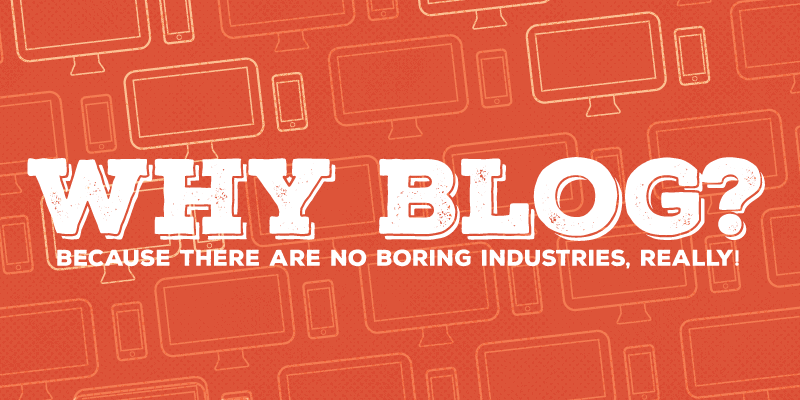Use these storytelling tips to turn your brand personas into customers!
Congratulations! You’re almost ready to start writing your blog posts. You understand the importance of telling your brand’s story. You’ve developed your voice (or voices!), and you’ve identified your audience. You even created a persona report for who you’ll be addressing in your posts.
Your next step is to do some keyword research and create an editorial calendar. Why? Keyword research isn’t only helpful with search engine optimization. We recommend putting in the time and effort to research keywords in your field because that’s how you’ll find out what your customers are looking for.
If you’re not a huge fan of keyword research, we can handle it for you with a BuzzAudit. I love writing, but SEO really brings out my inner geek!
When a fiction writer has an idea for a novel, she doesn’t write an entire book in one sitting. Of course, writing a book is different for all authors, but at some point, she’ll need to create an outline, write character descriptions (detailed like your personas will be), and more than likely perform a lot of research. Author Jodi Picoult researches extensively for her books, and she’s a bestseller!
I’ll bet you thought I’d never say this, but: It’s time to start writing! Here are some more storytelling tips for you to consider as you begin the journey of storytelling marketing.
Storytelling Tips: How to Handle a Blank Page
The cursor blinks, accentuating the stark white blank page, your fingers resting on the keyboard. Or maybe a pen is in your hand with a blank notebook willing you to write on it. Sometimes, getting started is the hardest part of creating content. Getting the momentum you need might feel impossible, but you have all the skills you need to succeed writing your blog posts.
Try freewriting.
Write anything that comes to mind on the topic. If doesn’t need to be good. It can be horrible. Give yourself the freedom to write the worst possible story or post that has ever been written. Once you’ve got everything you want to say on the page, all you need to do is edit the piece!
If you’re still stuck at the beginning, think about the personas you created. Pretend your office phone rings and on the other line is one of your personas. If you were having a conversation with them, and they were telling you their needs, how would you address them?
If you owned a bakery and received a call from a new mom who was out of work and on a budget, but still wanted to purchase something special for her one year old’s party, what would you suggest? Her needs dictate that she would like to order a special treat, though she’s reasonably concerned with price. Would you turn her away or would you offer some budget-friendly suggestions? Start here – with the make-believe phone conversation – and use it as a jump off for where to begin your blog post.
[Tweet ” Sometimes, getting started is the hardest part of creating content.”]
Storytelling Tips: What’s an Arc?
Where do you start telling your brand’s story? If we were in a college-level, beginner’s writing class, I’d teach you about the arc of a story. There are five parts: exposition, rising action, climax, falling action, resolution. Each plays its own role in completing a short story. While your blog posts won’t all need to follow the same arc, you should consider creating or following some type of structure to your posts.
The new podcast Serial has an flock of obsessed followers (I’m one of them!), but their story doesn’t follow a completely linear fashion. Sure, it starts off with the immediate facts: a young lady was killed in 1999, and her ex-boyfriend is now in jail for the crime. Every episode of the podcast starts off with questions. Was he the one to commit the crime? In this case, the questions are what drives the storyline. They are deliberate choices made by the person who is telling the story.
What will drive your brand’s storyline?
Will it be a story of hard work? Will it be tales from satisfied customers? Will you start your posts be full of action, leaving the readers on the edge of their seats? Will your story pull on the heartstrings of any of your personas?
[Tweet “What will drive your brand’s storyline?”]
Storytelling Tips: Authenticity and the Promise to Your Readers
If you’ve followed all the previous storytelling tips, you’re almost ready to press the publish button – or, perhaps more wisely, find an editor to take a look at your draft.
One more question for you, though.
Are you being authentic to your brand with what you’re publishing?
Your readers want you to be real. They want you to be authentic. There’s a secret contract of trust readers sign when they read your posts. Don’t exploit that.
One of my clients recently told me that communication was the most important part of her job (in the medical field). If she and her clients thoroughly understands each others’ needs and expectations, the outcome will always be positive. If there’s any miscommunication, expectations won’t be met. My client takes this very seriously, and both respects and honors her clients.
The same covenant happens between a blog writer and reader. If you’re true to your word, and you deliver what your readers expect, they’ll trust you. Your new readers will become customers. Your consistent readers develop into loyal brand ambassadors, supporting your brand identity.
You can turn those imaginary personas into real customers by following these storytelling tips: Be true to your brand’s story and meet the needs of your clientele!





